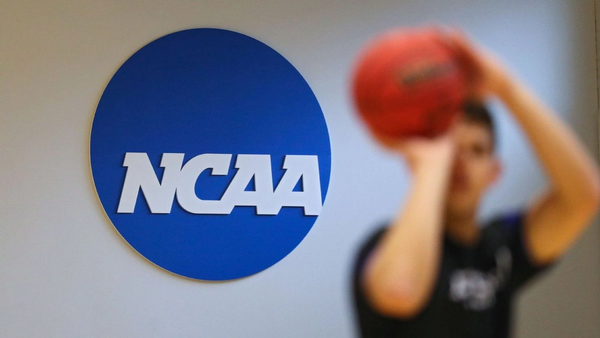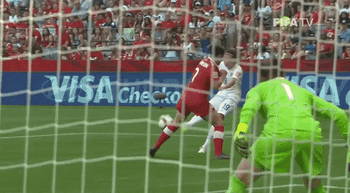
✏️ The terms of the deals
How did NIL begin? On July 1, 2021, the Supreme Court blew this sh!t wide open when, over strident objections, it killed the NCAA’s rules prohibiting college athletes from earning money off their personal name, image, and likeness. For the first time, athletes could be compensated for endorsements, branded social media posts, and similar activities.
- After that ruling, brands rushed to ink athletes like UConn women’s basketball star and Crocs queen Paige Bueckers, LSU gymnast and TikTok sensation Livvy Dunne, and our fave HVAC spokesman, ex–Nebraska football wide receiver DeColdest Crawford.
What’s an NIL marketplace? When student-athletes want to make some cold, hard cash, one option is to enter a marketplace — an online platform where they can connect with businesses and negotiate deals. Think Hinge, but for sponsorships.
- There are many marketplaces, and they compete for athletes’ patronage by vetting the brands and partnerships available on their platforms. Big ones include Opendorse, NOCAP Sports, and Icon Source.
What are NIL collectives? These are groups connected to, but not formally associated with, one or more schools. They pool money from boosters, businesses, and fans and funnel it to that institution’s athletes via NIL deals. For example, LSU boosters can contribute to the Bayou Traditions Collective, which could hypothetically pay the aforementioned Reese to appear at its donor events.
- There are various models, but the IRS’ categories include marketplace collectives that facilitate deals between outside businesses and athletes, donor-driven ones that create work for athletes to pay them directly, and dual collectives that do both.
- These groups are a hot-button issue because they can massively influence player recruitment and retention with the depth of their wallets, which many worry will create pay-to-play advantages for the wealthiest programs. More money, more problems.
📊 The data
By all measures, NIL’s growth shows no signs of stopping. Athletes earned more than $1B in year two, up from $917M in the era’s first year, and year three is already projected to reach $1.17B. And two years in, nearly 44% of athletes across all institutions are cashing in. The kids are more than alright.
- As far as top earners, football players have snagged 55% of all NIL compensation in 2023 so far, with Power Five (P5) starters snagging between $15K and $45K.
- Men’s hoops takes second place, but the top three players on Power Six rosters steal $75K on average. Sheesh.
So where are those deals coming from? Well, 80% of all NIL activities — appearances, posts, autographs, etc. — come from commercial sources, like sponsors and brands. But collectives are where the real money’s at: These donor-driven groups shell out 75% of all NIL compensation (nearly 80% in Division I [DI]).
At least 29 of the Top 50 Fortune 500 companies are in the NIL game, including Dunkin’, Beats by Dre, Nike, Adidas, and Degree, and brands leaned hard into year two, increasing NIL activity by 220%. It’s not all massive companies inking with college athletes, though — 46% of deals come from local brands, more than the 41% from national sponsors.
As for the 200-plus collectives, DI has a near-monopoly on them, with only two connected to DII or DIII schools. A whopping 122 are dedicated to P5 schools alone. Those DI collectives pay big bucks, too, averaging over $7K for each activity a P5 football player completes. P5 men’s and women’s hoopers collect average checks of almost $5K and over $2K per activity, respectively.
- Given the ever-increasing numbers, it’s estimated that top P5 collectives will need to ante up $10M annually to stay competitive in the space. Hope those pockets are deep.
💃 The gals
Since NIL’s birth, about 77% of all dollars have gone to male athletes, mostly skewed by the massive cash influx into football and the amounts invested by collectives. But without collectives or football? Women earn 46% of all NIL dough.
- Of the sports boasting the most NIL deals, five of the top 10 are women’s sports, and two are co-ed. The leaders? Women’s hoops and softball, which are third and fourth, respectively, behind football and men’s hoops.
With the women’s sports viewership boom and sports like women’s volleyball and softball joining the revenue-generating ranks, it’s no surprise that NIL deals are also increasing for the college girlies. Case in point? Women’s hoops deals grew 186% in year two, second only to those made by football players.
And the gals own the NIL social media game. Women college athletes generate more engagements than their male counterparts across all comparable sports, and they do it with 35% fewer athletes inking 10% fewer deals for 13% fewer posts than the guys. Because b!tches get stuff done.
- Leading the pack is the aforementioned Dunne, who earns up to $500K for a single social media post and boasts an NIL valuation that’s second only to new USC men’s hoops recruit Bronny James. Flip yeah.
👊 The impact
They say money can’t buy happiness, but it’s certainly having massive impacts across college sports, with athletes, institutions, teams, and brands all navigating the new deal-making waters. Here are just a few of the ramifications across the space.
⛹️ Athletes: College days are historically synonymous with being broke, and while that’s still overwhelmingly true, NIL has afforded many athletes the opportunity to pay some of those mounting educational bills in real time — a clutch move in an era of skyrocketing tuition and predatory student loans.
- Plus, with the help from NIL–specific curriculum popping up on campuses, NIL is teaching athletes key lessons in business, finance, personal responsibility, marketing, and personal branding — all before they can legally drink.
- For top earners, NIL dough is affecting decisions about when to go pro, with athletes now weighing college earnings — and the opportunities they provide — against rookie contracts.
📢 Teams: While NIL is undeniably impacting college sports in both recruitment and athlete retention, the actual correlation to on-field success is generally moderate. In NIL earnings by conference, only baseball and football currently show strong correlations between increasing NIL money and notching team dubs.
- But as NIL continues to become the rule rather than the exception, it’s looming ever larger in recruitment strategies, increasing allegations of inducements and player poaching from coaches of less-flush programs, with (almost) no repercussions.
🏫 Institutions: In response to first-year data that athletes were struggling to navigate NIL, schools stepped up in year two, offering the aforementioned NIL education and even integrating in-house general managers (GMs) directly into their athletic departments (ADs). Today, almost 60% of P5 schools have at least one full-time NIL–dedicated staff member.
- NIL also has schools concerned about their own bottom line. Booster donations that previously poured into ADs are being directly allocated to athletes via collectives, leaving colleges concerned about making up the difference, as well as the potential impacts on underfunded sports and Title IX compliance.
🔮 Zooming out
NIL’s second year crystallized its ever-growing role in the college sports space, but don’t get it twisted — this is still the wild, wild West. The entire NIL era was born out of a legislative and legal system that overrode the NCAA’s rules protecting its amateurism ideals. Since then, the organization has failed to substantially create or enforce NIL regulations.
Instead, states have passed a patchwork of laws which, on the whole, paved the way for their institutions to become more competitive in the NIL space, often in direct opposition to the NCAA’s guidelines. In response, the NCAA is laughably claiming its authority supersedes state laws, while more and more states (and schools) roll their eyes as they roll past the org.
That’s why the NCAA is desperately making moves to gain enforcement ground. From hiring former Massachusetts governor Charlie Baker as its president to lobbying Congress in hopes of an overarching federal law aligned with the governing body’s wishes, the NCAA is scrambling to contain the runaway train that NIL has clearly become.
- At the same time, the org is facing a barrage of state legislation, National Labor Relations Board inquiries, and major court cases further challenging student-athletes’ amateur status, an argument already on tenuous ground given the revenue involved.
But while NIL and the business landscape of college sports remains tumultuous, what’s most surprising might be what hasn’t happened: Amidst myriad concerns of NIL degrading parity in college sports, thus far they’ve become more competitive, with schools like TCU, San Diego State, and Cincinnati contending for national championships in the last 18 months.
- The jury’s still technically out, but if Wake Forest baseball can make its first Men’s College World Series since the 1950s, perhaps allowing athletes to earn some NIL dough is not, in actuality, the tragedy so many originally predicted.
Enjoying this article? Want more?

Sign up for The GIST and receive the latest sports news straight to your inbox three times a week.

